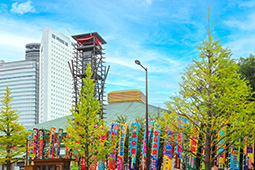May 2023
- English
- 日本語
Sumo Wrestlers and "Tai-mochi"
-

Mongolia-born Terunofuji holds two tai on the occasion of his promotion as the first Reiwa era Yokozuna (73rd overall). Photo: Japan Sumo Association -

Terunofuji receives the Prime Minister's Cup. Photo: Japan Sumo Association
-

The champion of the 2017 New Year's Grand Sumo Tournament (held in January) was decided in the final day's bout. The winner was Kisenosato, who was promoted to Yokozuna (72nd). Photo: Japan Sumo Association -

The bout that prompted Terunofuji to be promoted to Yokozuna Photo: Japan Sumo Association -

The January, May, and September Grand Sumo Tournaments are held at the Kokugikan National Sumo Arena in Ryogoku, Tokyo. During a tournament, festive banners line the area outside.

Sumo is said to be a Japan's national sport. In one custom of the sumo, when a professional sumo wrestler wins a tournament, or is promoted in rank to Yokozuna,* he poses for a commemorative photograph holding a sea bream (tai).
Sumo is one of Japan's traditional martial arts, a sport with a long history whose origins are said to date back over 1,500 years. In ancient times, sumo was held as a festival ritual to foretell the crop harvest. In the Nara period (from 710 to the end of the 8th century), it was held at the Imperial Court in front of the Emperor. Thereafter, in the Heian period (end of the 8th century to the the end of the 12th century), it became an annual event. Later, sumo was encouraged as training for battle by the samurai class, and the early modern period saw the emergence of professional wrestlers, as sumo became a spectator sport for the general public.
Athletic organizations for sumo wrestlers gradually formed along with modernization, and in 1925 a group that would become the foundation of the current Japan Sumo Association was established.
Today, the most prestigious sumo competitions held by the Japan Sumo Association are called by the special name "ozumo" (grand sumo).
Sometimes, sea bream plays an important role in ozumo. In Japan, it is considered an auspicious fish, and since olden times it has been given as a gift and used in celebrations to bring good luck. Because of this, there is a custom for special celebrations, for example, when a sumo wrestler wins a tournament or gets promoted to Yokozuna, for one or two large sea bream to be prepared for him to hold while posing for a commemorative photograph.

In today's ozumo, six honbasho (grand sumo tournaments) hosted publicly by the Japan Sumo Association are regularly held. It is said that when the champion wrestler is decided, the sea bream is prepared by that winning wrestler's heya (training stable). It is also said that large fish the size of the ones that the wrestlers hold rarely appear among the ones sold as food on the market. Most of these are products of nature, and the large ones that look so splendid are thought to be especially auspicious.

It is said that this ozumo custom was established about 200 years ago. It is no wonder that in this sport that esteems style and formality, each custom is passed down with great care.

Mongolian-born Yokozuna Terunofuji is currently very successful. After the July tournament in 2021, he was promoted to become the 73rd Yokozuna, he posed for his commemorative photograph holding two large sea bream. When he first began wrestling, he had smooth sailing up to the rank of Ozeki,** but suffered from a knee injury and went through a long period of setbacks. Terunofuji came through this and made a brilliant comeback, culminating in his ascension to Yokozuna. There is no doubt that the huge fish he held in each hand conveyed the desire for more and more success and health into the future.

* The highest rank for a wrestler. The currently active Terunofuji is the 73rd wrestler to reach this rank. Through history, not only Japanese, but also American-born (Hawaiian) and Mongolian-born wrestlers have held the rank.
** The second highest rank, after Yokozuna.

